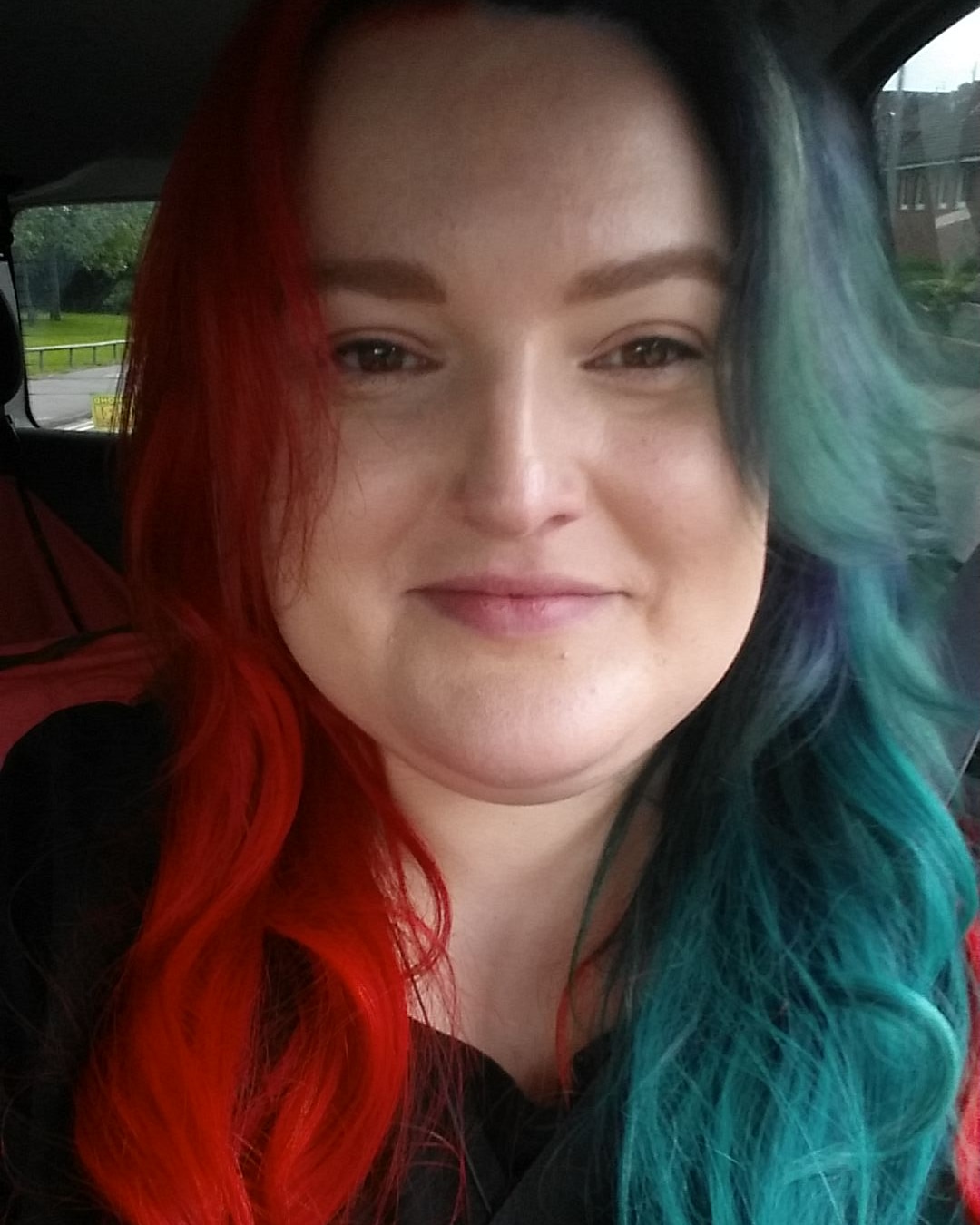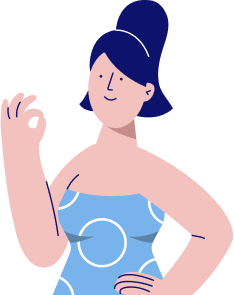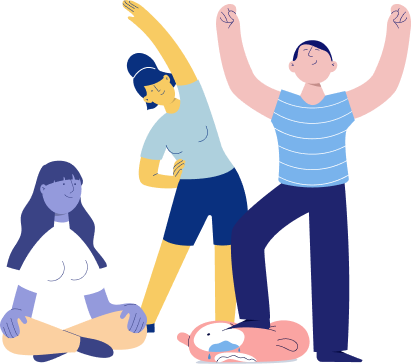Chronic pain is defined as pain which is long-term, lasting beyond 3 months. It’ll come as no surprise that chronic pain can sap the joy from your life and reduce your level of functioning. This study explains that, “In addition to the physical health consequences, chronic musculoskeletal pain can have a profound negative impact on an individual’s emotional and social well-being.”
The concept of living well while living with chronic pain can sound impossible, but you can thrive despite chronic pain. Living well with your chronic pain isn’t just about managing your pain, but rather about finding ways to live a happy, fulfilled life in spite of your symptoms.
I live with fibromyalgia and osteoarthritis. It has been a long journey to get used to living with my conditions but now I am living a happy life, meeting my goals and feeling extremely positive about the future. I won’t tell you it’s easy, but I will tell you it is possible.
- Acceptance and grieving
- Understanding it’s not your fault
- Learning about your condition
- Making healthy eating easy
- Finding exercise that you enjoy
- Being realistic about managing your weight
- Finding ways to sleep well
- Learning your limits and triggers
- Releasing guilt
- Finding joy and motivation
- Appreciating the little things
- Finding ways to reduce stress
- Distraction
- Don’t worry about what others think
- Finding others who understand
- Feeling comfortable asking for help
- Learning how to use mobility devices
- Surrounding yourself with supportive people
- Know that you are worthy of romantic love
- Learning to be assertive
- Finding ways to maintain social connections
- Planning your activity
- Combating cognitive issues
- Building self esteem
- Advocating for yourself
- Researching medications
- Seeking therapies
- Accepting that recovery is possible
- Being a warrior
Acceptance and grieving
When you are first diagnosed with a chronic pain condition, it can be a lot to take in. Learning that the pain you have been experiencing is not going away anytime soon can be overwhelming. It’s so important to give yourself the time to accept your diagnosis. This study found that, “acceptance of chronic pain was associated with less pain, disability, depression and pain-related anxiety, higher daily uptime, and better work status. “

It’s ok to feel distraught, confused and upset. It’s an incredibly hard thing to hear that you have a long-term health condition. But don’t be too hard on yourself. The way you are feeling is completely valid. It’s ok to grieve who you were before you became chronically ill, and the life that you once led. I have been there. I grieved the dreams I once had and how physically fit I used to be. I felt completely overcome by the thought that I would have to live in pain.
Give yourself this time of acceptance and grieving, but don’t allow yourself to become stuck in that place. It’s time to dust yourself off and figure out how you can live your life despite your illness.
Understanding it’s not your fault
The next vitally important stage is to understand that this is not your fault. You will hear that there are ‘pain inducing’ behaviours, and that you need to change things in order to manage and reduce your pain. This is true, but does not mean that you have caused this pain or that it’s your fault you are in this situation.
Learning about your condition
Finding out about your diagnosis and chronic pain in general allows you to understand what is happening within your body, and gives you a good basis to work from. Do plenty of research online: read articles, blogs, studies and watch videos. If you have questions, make a list to take to your doctor or specialist next time you have an appointment.

Understanding how chronic pain works can give you a sense of confidence. It can allow you to understand that even though it’s painful, chronic pain is not damaging your body. This can enable you to be less fearful when you are in pain. This study explains that pain neuroscience education, meaning being educated in the science behind pain, is effective in “reducing pain and improving patient knowledge of pain, improving function and lowering disability, reducing psychosocial factors, enhancing movement, and minimizing healthcare utilization.”
When I was diagnosed with fibromyalgia, my doctors told me that I would just have to learn to live with it. I was never given any indication that it could get better or that it could be treated! I wasn’t told any of the science behind the condition and so was left fearful that when I was engaging in activity and felt pain, that I was harming my body.
Through my own research, I figured out that I wasn’t in danger. I learnt that pain, while it hurt, wasn’t actually damaging me and so I became much less afraid. I learnt that chronic pain could improve, that there are ways that you can get a handle on it. I became even more determined to get my life back and not let it beat me!
Making healthy eating easy
Learning to provide your body with the fuel it needs to function optimally is so important when you are trying to fight chronic illness. Your body needs the right nutrients for all aspects of functioning, including keeping your immune system working and generating energy.
Eating well doesn’t have to be complicated or fancy. When you live with chronic illness, things are hard enough. You don’t need to give yourself more work than you need to.

I’ve found preparing meals in advance really helpful, so that if I’m fatigued or flaring, there is something healthy and quick at the ready. This helps me to avoid grabbing something unhealthy. Me and my husband do food prep, meaning that we cook and prepare our meals once or twice a week and just heat them up when we want them. This helps us to keep up with healthy eating habits and control our portion size.
You don’t have to cook everything from scratch. When you’re shopping, grab things like pre-prepared vegetables. They’re just as healthy as ones you peel, chop and prepare yourself and it saves your energy for other activities. Some microwave meals are healthy; do your research and figure out what provides the right nutrients.
A slow cooker is something I find amazingly useful. There are plenty of recipes that allow you to just throw all the ingredients into the slow cooker together in the morning, and a healthy warm meal is waiting for you at the end of the day. Gadgets like an electric can opener makes easy work of tins.

Using gadgets and pre prepared items to make life easier for yourself is not giving in; it’s quite the opposite. Utilizing tools which increase your functioning and help you to focus on adaptative (meaning helpful) behaviours to manage your illness, is an incredibly positive thing.
Finding exercise that you enjoy
Exercise has so many health benefits and is proven to reduce chronic pain symptoms. It can sound impossible to start exercising when you are in pain, but it really can help. This study explains the importance of exercising, stating that, “prolonged disengagement from activities may result in physical deconditioning, economic loss and further emotional distress as a result of the loss of psychosocial functions” and going on to explain that exercise is key to increasing your level of functioning, managing your pain and improving quality of life.
Starting to exercise with chronic pain is a process of building up slowly, pacing your activity so that you can build up your fitness and a tolerance to exercise without causing a flare in symptoms. This can be a hard balance to strike and is trial and error, but is so worth it.
Doing an exercise that you enjoy gives you the motivation you need to face the pain and carry on despite it. There are so many types of exercise out there, from yoga, swimming, hiking or biking; you can find what feels right for you.

My exercise journey surprised me. I started out from barely being able to walk across the room without flaring, and over months built up to going on hikes. Now I can hike rough trails for miles without flaring. It was a slow process and it was hard work, but hiking with my dogs makes me truly happy.
I was surprised by how much my pain in general reduced as I increased my fitness. I have more low or even no-pain days in general since I have started exercising, and my energy and level of functioning has increased vastly.
Being realistic about managing your weight
It’s important to keep your weight at a healthy level where possible, so that there is less weight on your joints. This is particularly important with conditions like arthritis where the joint is worn down.
This is something I struggle with. I’m very overweight due to the side effects of medication for bipolar disorder which I also live with, combined with it being tough to exercise as much as I’d like while living with chronic pain. I constantly try to combat this to improve my physical health. It’s an ongoing journey for me, one that I will not give up on.

I have learnt that it’s so important not to be too hard on yourself. Nobody is perfect. If you are doing your best to manage your weight and improve your life, then that’s more than good enough.
Finding ways to sleep well
Sleeping can be one of the toughest things to achieve when you’re in pain, yet fatigue is almost ever present. This study explains how detrimental a disturbed sleep routine can be: ”sleep disturbance interacts with central pain processing and inflammatory mechanisms to augment pain, low mood and poorer physical functioning”
Finding ways to improve your sleep routine can be so beneficial to increasing your energy levels and balancing your mood as well as reducing pain. I’ve found that getting up at roughly the same time in the morning consistently, even if I haven’t slept well, really helps. I try to minimize naps during the day; it’s not always possible to eliminate them but reducing their frequency and length is helpful.
Being active during the day helps your body and mind to be tired enough to sleep. Since I started exercising, I can see the difference in the days when I do and don’t exercise regarding how well I sleep.
If you take medications which have sedative side effects, taking them about half an hour before bed can let you use those side effects in your favour. Winding down before bed is important to prepare your body to sleep. This can be whatever makes you feel most relaxed. It could be mindfulness meditation, listening to an audio book or relaxing music or reading a book in bed. Making your bedroom cosy and comforting is relaxing too!

Learning your limits and triggers
You’re not always going to be able to do everything that you want to; that’s tough to learn and to accept. It’s important to stay active and not let your chronic pain rule your life, but it’s also important not to be constantly overdoing things to the point of a flare in your symptoms.
Figuring out what triggers flares in your symptoms is a vital tool you can use to your advantage. Monitoring your pain levels can allow you to see patterns and figure out what might have caused a flare. This knowledge gives you the power to tackle your triggers in a gradual way to overcome them..
Finding a balance and learning your limits can take time, so remember to be patient with yourself.
Releasing guilt
It can be all too easy to feel guilty about not being able to keep up with what your loved ones are doing or for needing to ask for help. In order to live a happy life with your chronic illness, you need to release this guilt.
That’s easier said than done and certainly takes time. However, as you learn how to live well with your illness, how to manage your pain and increase your functioning, guilt can be replaced with a sense of empowerment, determination and confidence.
Pathways Helps You Break The Pain/Fear Cycle
Enjoy any one of our hundreds of meditations
Finding joy and motivation
Chronic pain can often sap all the joy out of your life. It doesn’t have to stay that way though! Once you get a handle on your chronic pain and figure out how to manage your symptoms, you can start to find joy in your life again!.
Finding joy can be anything that makes you happy! It could be something like attending a class once a week, taking up a new hobby, having a pet, making new social connections or getting back to work.

When your level of functioning is low, it can feel as though your life is all about your chronic pain, but you can shape your future and find purpose again. The goals that you set for the future might not look exactly as they used to but they can be just as wonderful.
Sometimes it might take longer to achieve your goals and you may have bumps in the road, but if you set goals you really feel passionately about, you will have the motivation to overcome your symptoms and persist until you are successful. This study on assessing quality of life in those with chronic pain explains that, “One of the mechanisms by which improvements are hypothesized to occur is via a shift in patient focus away from a primary goal of pain reduction toward goals associated with living meaningful and productive lives.”
When I was first diagnosed my symptoms were my whole life. As I learnt how to reduce my symptoms and had the confidence to tackle them, I began to find joy and set new goals. I found joy in my wonderful husband, family and friends. I began to write again which was something I had always loved. I used to want to work with animals, but now I still have them in my life as pets and that’s just as beautiful.
I set new goals, writing part time and doing admin work for the rest of the time. I knew that I wanted to write full time and so continued to work on gaining experience, and in 2019, I finally got the opportunity I had been working towards. I am now a full-time writer and it fills me with joy and pride to say that.

It took years to learn to manage my condition, but I did it and it was so incredibly worth it! I can’t describe how grateful I am for that. You can find new goals and you can achieve them!
Appreciating the little things
Another way to draw joy into your life is to really appreciate the ‘small’ things in life. Praising yourself for small achievements like taking a shower, getting up and dressed or doing some exercise for example. Don’t dismiss those things as something you ‘should’ be able to do, instead praise yourself every step along the way and celebrate those achievements, because they are tough, and they do deserve to be celebrated.
So often people rush past simple joys, when those little things can really bring such happiness if they are appreciated fully. Find joy in small things like a TV programme you enjoy or a tasty piece of cake. Really soak up that moment and take notice of the happiness it brings.
Finding ways to reduce stress
Being in pain is stressful, but stress causes and worsens chronic pain. It’s an ongoing cycle but one that you can work on breaking. Finding ways to reduce stress in your life can help immensely. Taking some time to really look at what causes you stress is helpful, and then addressing them one by one.
Be sure to talk to someone you trust about your feelings; it can feel like a weight has been lifted off your shoulders when you share your problems rather than keeping them to yourself.

Learning how to implement mindfulness into your day to day life as well as carrying out mindfulness meditations can help you to relax and reduce stress. This book describes mindfulness as, “to live in the moment, notice what is happening and make choices about how you respond to your experience rather than being driven by habitual reactions”; essentially mindfulness gives you more control over your emotions and your behaviours.
Learning how to reduce your symptoms and better manage your pain allows you to feel more in control. Seeking therapies can help you to tackle hypervigilance, catastrophizing and fear about your pain, which can take away a big part of the cause of stress in your life.
Distraction
Something that I have found immensely helpful when I am flaring is distraction.Changing your environment can be useful, even if this is just moving into a different room. Listening to music, talking to someone, engaging in crafts, basically anything that keeps you busy and which gives you something other than your pain to focus on, can make it easier to deal with.
Don’t worry about what others think
This is easier said than done but learning not to worry about what other people think of you can give you an immense sense of freedom. Illnesses which are invisible like most chronic pain conditions, tend to carry a lot of stigma. People don’t always understand what they cannot see; unfortunately, that often leads to judgements or stigmatizing comments. The less weight you give other people’s judgements, the more confidence you gain.
We are all beautiful and amazing in our own ways, and everyone goes through struggles in their lives. You know what you are going through and that’s what matters.
Finding others who understand
Being able to talk to other people who really understand what you are going through because they go through it themselves, is so validating. You may be able to join local support groups or you can find support online through social media or chat rooms.
Twitter provided a lifeline for me when I had nobody else in my life who had experienced my conditions, and some of the friends I have made there will be lifelong.

Feeling comfortable asking for help
Needing to ask for help can feel embarrassing. It can be all too easy to feel like a ‘burden’ when you need to ask loved ones for assistance with day to day tasks. It’s important to remember that everybody needs help sometimes. Releasing the guilt that comes along with asking for assistance is much easier said than done though.
I try to combat this by explaining to my loved ones in advance what I am going through, so that when I ask for help they have a better understanding of why. Remembering to thank them for all they do can make them feel very appreciated.
I try to remember that I am there for them in so many ways, even if those ways are sometimes different than how they are there for me. The concept of needing help sometimes can still be frustrating, even if your loved ones are really understanding; this is something I am still working on.
Learning how to use mobility devices
Mobility devices are there to increase your level of functioning, to enhance your quality of life. Utilizing them when they could help you to do more and cope better is nothing to be ashamed of. The key here is to find a balance. It’s important to still push yourself to manage your chronic pain and be active when you are able. This study concluded that when used correctly, “mobility devices improve users’ activity and participation and increase mobility.”
For example, I have a mobility scooter which I used to need a lot more than I do now. I used my scooter to get out of the house on days when I was flaring and would not otherwise have been able to walk without causing extreme pain, so I was still able to function. The key was when my pain was low but still present, to continue expanding my exercise and activeness without the scooter, even though it was there, and I could have made life easier using it. It’s about finding a balance between using aids when you really need them, but not allowing them to interrupt your progress in building up your activity levels.
Surrounding yourself with supportive people
You need people in your life who are going to be understanding and supportive. If there are people in your life who don’t accept or understand your condition even after you have tried to educate them, it may be time to consider putting your wellbeing first.
Know that you are worthy of romantic love
Everybody, regardless of physical ability or mental illness, is worthy of love. If you have that love in your life, try to understand that you are worthy of it. Iit can be all too easy to start pushing a partner away because you feel like a burden.

If you don’t have romantic love in your life and you want it, don’t allow your chronic illness to stop you seeking it. The right person will love you for exactly who you are.
Learning to be assertive
There are times when you may feel that an activity is too much for you. Learning to be assertive and understand that you have a right to say, ‘no thank you’ is important.
Being assertive with yourself is equally as important. There will be times that it will feel easier to just rest rather than push yourself to be proactive in managing your pain. Equally there may be times when you want to continue an activity even though you know you need to rest. It’s a skill to learn to be assertive with yourself in doing what is best for your health.
Finding ways to maintain social connections
Isolation is so common in those with chronic pain. Often we may feel we cannot keep up with others or that they might not understand. Sometimes fear of pain worsening can lead to avoiding activity. Most humans need social connections in their lives to be truly happy. To live well with your pain, you need to have those connections in your life.
This age of technology affords plenty of options to keep in touch with those we love, even if we don’t feel up to getting out of the house at times. Using video calls, texts, phone calls and social media can allow you to nurture connections.

Trying to form a social life that works for you. You could explain to your friends that you can only do so much and arrange nights out around these boundaries. You may form friendships with people who already understand your condition and who have similar levels of functioning as you do. You could host social nights at home, inviting loved one’s round if you don’t feel up to going out.
Planning your activity
You can utilize times that you have low pain to your advantage. However, it’s vital not to overdo things as this can lead to the boom and bust cycle (meaning that you try to fit everything you can into a ‘good day’ and end up causing a flare). Instead, learning to pace your activity and utilize good days without going overboard, is the most effective way to optimize your productivity.
Combating cognitive issues
Issues with concentration, memory and cognitive processes can be symptoms of chronic illness. I struggle with fibro fog, which makes it hard to function at times.
Keeping notes and reminders can help you remember important things. Setting alarms for appointments, to remember when to take medications or when your pet needs to be fed for example can be useful.
One of the things that has been my greatest weapon in coping with fibro fog, is finding humour in it instead of letting it frustrate me. When my brain comes up with a random word instead of the one I was aiming for, my husband and I have a giggle at how silly my brain can be. When I forget why I walked into a room, I shrug and smile, thinking to myself ‘fibro fog strikes again’.
Pathways Helps You Break The Pain/Fear Cycle
Enjoy any one of our hundreds of meditations
Building self esteem
Having chronic illness can drain your confidence, making you feel you aren’t the same person you were before. It can make you feel in conflict with your body because it feels as though it’s betraying you. This study found that chronic pain “changes the individual’s experience of him/her self”
As you learn to deal with your symptoms these feelings can be reduced. It’s important to remember that you are the same person you were before your illness, if anything, you are stronger and more powerful. Your body is not broken; chronic pain does not lessen your worth.
When you have a negative thought about yourself, actively replace it with a positive one. For example, if you struggle to wash the dishes and need to ask for help, your brain may default to a thought like “you should have been able to do that, what a failure”. Instead actively replace it with a more positive thought like “you are living with chronic pain and doing your absolute best, you tried your hardest to wash those dishes!” Over time this becomes a useful habit and one that can help you to see yourself in a more positive light.
Making lists of things that you are proud of about yourself or about what you have managed to do that day can be a great way to get into the habit of actively thinking about yourself in a positive way. Practicing self-care can aid greatly in building confidence.
Advocating for yourself
Medical professionals don’t always get the training they need to diagnose and treat chronic pain, so although it shouldn’t be needed, advocating for yourself becomes important. Ensure that you ask any questions you have, that you persist in seeking answers and treatment for your condition. Do your own research to learn about your symptoms, diagnosis and available treatments and don’t be afraid to present these ideas to medical professionals.
If you don’t feel able to advocate for your own care alone, you could ask a loved one to go with you. Some chronic illness charities may offer support in this area. Some may even offer patient advocates to attend appointments with you.

Researching medications
Medical professionals may offer you various painkillers and other medications to treat your chronic pain. For some people these will be appropriate, while for others they may not be suitable.
Ensure that you do not feel pressured to take medications. Do research online into side effects and ask your doctor plenty of questions before you start a new medication.
Seeking therapies
There are therapies out there which not only help you to cope with your pain, but literally help to reduce and even eliminate your symptoms! Various therapies are available which you can research and seek through your doctor, find privately or access through a pain therapy app (like ours).
This study states that, “Patients should work in partnership with health-care professionals, actively participating in their care.” Available, scientifically proven therapies include the following:
- Cognitive Behavioural Therapy (CBT)
- Acceptance and Commitment Therapy (ACT)
- Mindfulness
- Graded Motor Imagery
- Graded Exposure Therapy
- Physical Therapy (PT)
Accepting that recovery is possible
Scientifically proven therapies can help you to recover from chronic pain. ‘Chronic’ does not equal lifelong! This is something that can be hard to get your head around, because medical professionals and society tends to tell us the opposite. Take your time to do your own research to accept and set your mindset to recovery.
Remember that recovery will look different for everyone. For some it will be reducing symptoms and functioning well while living with chronic pain. For others it may be eliminating their chronic pain completely.
Understand that recovery will be a long road. Recovery isn’t linear. You might have setbacks and it’s inevitable that you will have flares in symptoms, but this doesn’t mean that the work you have already done towards your recovery is discounted, or that you cannot succeed.
Being a warrior
Recalibrating your mindset to pure determination to keep fighting and to overcome your struggles is important. There may be hard times but determination to get up and keep going is vital, even if that means you need help to do so.
I may have times when I feel defeated, but I don’t let those times persist. I am a warrior, determined to keep progressing and forging a path forward. You are a warrior too. We wake up every day and fight on in spite of our chronic illness. We can overcome our chronic pain.
References
- Scandianvian Journal of Caring Sciences, Volume 21, Issue 3, Pages 291-296, Maria Afrell MSc, RPT Gabriele Biguet MSc, RPT Carl Edvard Rudebeck PhD, MD, (2007), “Living with a body in pain – between acceptance and denial”
- Nicole K. Y. Tang ,Adam N. Sanborn, (2014), “Better Quality Sleep Promotes Daytime Physical Activity in Patients with Chronic Pain? A Multilevel Analysis of the Within-Person Relationship”
- Vidyamala Burch, (2010), “Living Well With Pain and Illness: The Mindful Way To Free Yourself From Suffering”
- Best Practice & Research Clinical Rheumatology, Volume 21, Issue 3, Pages 567-579, Emine HandanTüzün PT, PhD (2007), “Quality of life in chronic musculoskeletal pain”
- Pain, Volume 105, Issues 1–2, Pages 197-204, Lance M McCracken, Chris Eccleston, (2003), “Coping or acceptance: what to do about chronic pain?”
- Pain Medicine, Volume 16, Issue 11, Pages 2109–2120, Mark P. Jensen, PhD, Kevin E. Vowles, PhD, Linea E. Johnson, BA, Kevin J. Gertz, MPA, (2015), “Living Well with Pain: Development and Preliminary Evaluation of the Valued Living Scale”
- Physiotherapy Theory and Practice, An International Journal of Physical Therapy, Volume 32, 2016 – Issue 5, Adriaan Louw , PT, PhD,Kory Zimney , PT, DPT,Emilio J. Puentedura , PT, DPT, PhD &Ina Diener , PT, PhD (2016), “The efficacy of pain neuroscience education on musculoskeletal pain: A systematic review of the literature”
- Journal of Rehabilitation Medicine, Volume 41, Number 9, pp. 697-706, Salminen, Anna-Liisa; Brandt, Åse; Samuelsson, Kersti; Töytäri, Outi; Malmivaara, Antti, (2009), “Mobility devices to promote activity and participation: A systematic review”
- Practical Pain Management, Volume 11, Issue 6, Forest Tennant, MD, DrPH, (2012), “A Diet for Patients With Chronic Pain”
- Practical Pain Management, (2019), “50-Plus Resources, Including Groups for Veterans, to Help You Live Better with Chronic Pain”
Please note: This article is made available for educational purposes only, not to provide personal medical advice.












